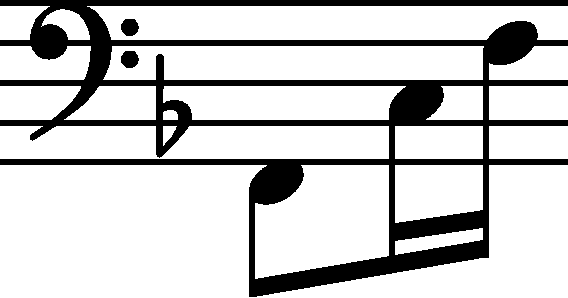



Pitch
- « Previous
- 1
- 2
- 3
- Next »
|
b. 14
|
composition: Op. 28 No. 23, Prelude in F major
..
There is no category imprint: Interpretations within context; Differences between sources issues: EE revisions , Accidentals in different octaves , Fontana's revisions , Inaccuracies in A , Errors repeated in FE |
||||||
|
b. 16
|
composition: Op. 28 No. 23, Prelude in F major
..
The missing f2 crotchet in FC (→GE1) may be a result of an unfinished or failed correction of the pitch of that note – in the place where the stem of the chord ends, e2 was probably removed. Another possibility is a misrepresenting its notehead in A for a mere thickening at the end of stem. The copyist also omitted the arpeggio sign before that chord and the slur. The revision restoring a tolerably correct text in GE2 (→GE3) was most probably based on FE, which is indicated by an identical unification of the rhythmic values of the g1-b category imprint: Differences between sources issues: Different values of chord components , Inaccuracies in FE , GE revisions , Errors of FC |
||||||
|
b. 17-18
|
composition: Op. 28 No. 23, Prelude in F major
..
In A one can decipher the crossed-out, earlier version of the L.H. part, which was written an octave higher, hence these bars were an exact transposition of b. 9-10. At the same time, we can see that it was b. 18 that was changed first, since Chopin initially put a bass clef at the end of b. 17, which must have still been written in the treble clef. The corrections in the next bars reveal that the changes were a final stage of a broader transformation process of the entire ending of the Prelude. category imprint: Corrections & alterations; Source & stylistic information issues: Corrections in A , Deletions in A |
||||||
|
b. 18
|
composition: Op. 28 No. 23, Prelude in F major
..
FC did not mark the change of clef, which was corrected in GE. The pencilled clef was added later by Hermann Scholtz. category imprint: Interpretations within context; Differences between sources; Source & stylistic information issues: GE revisions , Foreign hand additions in manuscripts , Errors of FC |
||||||
|
b. 19-22
|
composition: Op. 28 No. 23, Prelude in F major
..
The extensive crossings-out in A – the entire ending of the piece starting from b. 19 was eventually crossed out and had to be rewritten – reveal that Chopin was looking for the best way to transfer the figuration from the topmost register back to the middle range of the instrument.
category imprint: Corrections & alterations; Source & stylistic information issues: Corrections in A , Deletions in A , Accompaniment changes , Main-line changes |
- « Previous
- 1
- 2
- 3
- Next »

 raising b
raising b 3 to b3 in
3 to b3 in  . The notation bears traces of local corrections performed before the entire ending was crossed out, hence it seems impossible to decipher all elements of notation, not to mention determining the order of versions, without specialised studies (e.g. one can see an even earlier – crossed out separately – notation of the beginning of the 2nd half of the bar
. The notation bears traces of local corrections performed before the entire ending was crossed out, hence it seems impossible to decipher all elements of notation, not to mention determining the order of versions, without specialised studies (e.g. one can see an even earlier – crossed out separately – notation of the beginning of the 2nd half of the bar  ).
). . On the 1st beat of b. 21 one can see traces of corrections suggesting that, e.g. the initial F note was a semiquaver. Chopin then crossed out the entire notation of that bar and rewrote it on a stave below in the final version. However, the latter was also crossed out, since the accumulation of corrections and excess of bars forced the composer to rewrite b. 19-22.
. On the 1st beat of b. 21 one can see traces of corrections suggesting that, e.g. the initial F note was a semiquaver. Chopin then crossed out the entire notation of that bar and rewrote it on a stave below in the final version. However, the latter was also crossed out, since the accumulation of corrections and excess of bars forced the composer to rewrite b. 19-22.